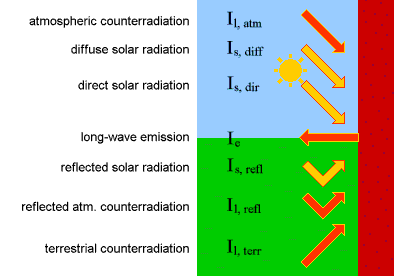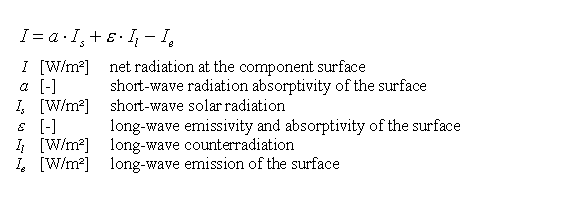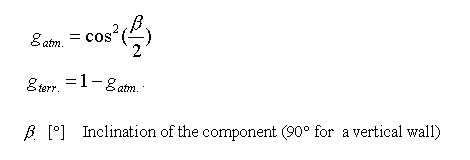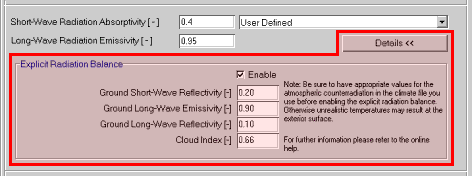Details:LongWaveExchange
Long-wave Radiation Exchange
Introduction
The temperatures of exterior surfaces are determined by heat flow due to heat conduction within the component, by convective heat exchange with the ambient air and, last not least, by radiation exchange with the surroundings.
Short-wave radiation (with wavelengths around 0.5 - 1 µm) comes from the sun,
reaches intensities up to about 1000 W/m² and shows a pronounced daily variation,
being absent at night. Building components absorb short-wave radiation, but they do not
emit it themselves.
Long-wave radiation (with wavelengths around 10 µm) is emitted as thermal
radiation by terrestrial objects (such as walls, the ground etc.), reaches intensities of
several hundred W/m² (depending on the temperature of the emitting surface) and is
always present. Building components absorb long-wave radiation emitted from other objects,
but they also emit such radiation themselves and are thus in continuous radiation exchange
with their surroundings. The long-wave portion present in the solar radiation is completely
negligible in comparison with the long-wave radiation emitted by terrestrial sources,
since the solar disk is a source with much smaller angular extension.
Since the terrestrial objects involved in the radiation exchange tend to have mutually similar temperatures, their long-wave radiation exchange is quite balanced, and despite the considerable amounts of energy passed back and forth, the exchanged net radiation flows are comparatively low. The equation describing the long-wave radiation exchange contains the involved absolute temperatures to the fourth power, but because of the relatively small temperature differences, it can be linearized in good approximation. The energy flow is then proportional to the temperature difference of the involved objects:
and it thus behaves quite like the convective heat flow between the surface and the ambient air:
Assuming that the surrounding objects have approximately air temperature and that all objects have similar emissivities, the two equations can be combined into one equation describing the total heat flow caused by convection and radiation (see also the discussion of the heat transfer coefficient):
In building physics this approximation equation is usually used for computing the heat
exchange; it is thus not necessary to allow explicitly for long-wave radiation exchange.
WUFI, too, usually computes the heat exchange with the surroundings in this way.
Nighttime radiation cooling
Even if a component surface has the same temperature as the terrestrial surroundings, it nevertheless suffers some long-wave radiation loss. This is because it exchanges radiation not only with the terrestrial surroundings but also with the sky; that is, with the atmosphere as radiation exchange partner. However, the constituents of the atmosphere are poor thermal emitters: the biatomic molecules N2 and O2 emit almost no thermal radiation at all, and only the trace amounts of the so-called greenhouse gases (water vapor, CO2, O3 etc.) are able to emit long-wave radiation because of their molecular structure.
They are very efficient emitters, but unlike solids and liquids which emit a continuous radiation spectrum ("Planck spectrum"), gases only emit line spectra with considerable gaps around certain wavelengths. Thus, compared to the radiation emitted by a solid with the same temperature, the total radiation emitted by the atmosphere is less by the amount missing in the gaps.
Therefore, while a component surface radiates its long-wave emission evenly into the whole half-space, only the radiation it receives from the solid angle occupied by terrestrial objects (the so-called terrestrial counterradiation) has comparable intensity. The long-wave radiation received from the solid angle occupied by the sky (the so-called atmospheric counterradiation), on the other hand, has usually less intensity than the emission radiated towards the sky - even if the atmosphere and the emitting surface have the same temperature. Thus a component surface emits more radiation than it receives from the surroundings as a whole, and it suffers a continuous heat loss.
By day, this heat loss is not noticeable because of the heat gained by incident solar radiation. By night, however, the loss is not compensated and usually causes cooling of the surface below ambient air temperature ("overcooling"). Dew deposition and the risk of algae and mold growth may result.
Clouds consist of water droplets or ice crystals which emit a complete Planckian spectrum. If there are clouds in the sky, they may partially or completely compensate the radiation deficit of the atmosphere. Thus, besides temperature and water vapor content, the intensity of the atmospheric counterradiation strongly depends on the current amount of cloud cover. Typical values at temperate latitudes for the counterradiation emitted by a cloudless sky range between about 180 W/m² (cold, dry air) and about 400 W/m² (warm, humid air). With a closed opaque cloud cover, the sky behaves like a Planckian emitter whose temperature is equal to the dew point temperature of the air.
The extent of the radiation losses (and thus of the overcooling) also depends on the inclination of the surface. Horizontal surfaces (e.g. flat roofs) exchange radiation with the sky only and thus overcool very strongly. Vertical surfaces (e.g. facades) only suffer a loss towards a part of their field of view while the exchange with the remaining (namely, terrestrial) part of their field of view is usually quite balanced.
Surfaces with low thermal inertia (e.g. surfaces of ETICS) are overcooling stronger
during a night than surfaces with larger thermal capacity (e.g. surfaces of massive
walls).
Radiation components
If overcooling occurs, the radiative and convective heat flows at the surface go in opposite directions: radiative power is lost from the surface towards the sky, while the convective heat flux flows from the (warmer) ambient air towards the (cooler) surface. This situation cannot be treated with the simplified formula (see above)
which rests on the premise that both energy flows go in the same direction. If overcooling shall be modelled in a simulation, the radiation part must therefore be removed again from the heat transfer coefficient, and long-wave radiation exchange must be computed separately from convective heat exchange. It will be advantageous to combine short- and long-wave radiation exchange into a single comprehensive radiation balance.
If the user instructs WUFI to use such a complete radiation balance, it accounts for the following short- and long-wave radiation components (cf. [2]):
- direct solar radiation:
the fraction of solar radiation which comes directly from the sun, as incident on the building surface. WUFI uses the position of the sun and the orientation and inclination of the surface to compute it from the direct horizontal solar radiation, which in turn can be read from the weather file or can be computed from global and diffuse solar radiation.
- diffuse solar radiation:
the fraction of solar radiation scattered by the atmosphere and by clouds, incident from all directions.
This value has to be multiplied by the viewing fraction of the sky (see below); the result is the component of diffuse solar radiation incident on the building surface.
- reflected solar radiation:
the short-wave radiation which reaches the building surface after having been reflected by the ground or other terrestrial objects. This value is computed from the sum of direct and diffuse solar radiation, and the terrestrial short-wave reflectivity.
It then has to be multiplied by the viewing fraction of the terrestrial surroundings (see below); the result is the component of reflected solar radiation incident on the building surface.
- atmospheric counterradiation:
the long-wave radiation emitted by the sky (atmosphere + clouds).
Depending on the weather file type it may be read directly from the file, or it may be estimated from other weather elements and the cloud cover, using an empirical counterradiation model. Some file types contain hourly values for the cloud cover, otherwise the user can specify a fixed value for the cloud cover (strongly degrading the quality of the counterradiation estimates).
These counterradiation values have to be multiplied by the viewing fraction of the sky (see below); the result is the component of atmospheric counterradiation incident on the building surface.
- reflected atmospheric counterradiation:
the atmospheric counterradiation which reaches the building surface after having been reflected by the ground or other terrestrial objects. This value is computed from the atmospheric counterradiation and the terrestrial long-wave reflectivity.
It then has to be mulitplied by the viewing fraction of the terrestrial surroundings (see below); the result is the component of reflected atmospheric counterradiation incident on the building surface.
- terrestrial counterradiation:
the long-wave radiation emitted by the terrestrial surroundings.
Depending on the weather file type it may be read directly from the file, or it may be estimated from the ambient temperature and the emissivity of the terrestrial surroundings (e.g. the ground), using the Stefan-Boltzmann law (it is assumed that the effective temperature of the objects in the terrestrial surroundings is equal to the ambient air temperature).
These counterradiation values have to be multiplied by the viewing fraction (see below) of the terrestrial surroundings; the result is the component of terrestrial counterradiation incident on the building surface.
- long-wave emission:
the long-wave radiation thermally emitted by the exterior surface of the building component. It only depends on the temperature and the long-wave emissivity of the surface.
Simplified WUFI method (recommended for most applications):
The transport equations used by the previous WUFI versions (and by WUFI 4.2 in the default simplified calculation mode) offer two mechanisms for heat addition or removal: heat exchange with the ambient air (across the exterior and the interior surface), and a heat source or sink at the exterior surface. (A third mechanism, heat liberated by latent heat effects is ignored in this section).
This simplified calculation mode accounts for the long-wave radiation exchange by using
a heat transfer coefficient which includes some long-wave contribution, as discussed above.
Convective heat flow and long-wave exchange are thus treated collectively as heat exchange
with the ambient air.
In contrast, the short-wave (solar) radiation is treated as a heat source at the component
surface whose source strength is given by the irradiation incident on the surface,
multiplied by the short-wave absorptivity.
If the specified weather file has another format than *.TRY or *.DAT, then WUFI does not distinguish between day and night. At night, merely the heat source (due to radiation) is zero since then there is no solar radiation. No overcooling can result.
However, if a weather file in test reference year format ( *.TRY or *.DAT) [##WAC?##] is used, WUFI tries to account for overcooling in a rudimentary way at least, and for this it uses the following simplified method:
- During the day WUFI only indirectly accounts for long-wave exchange by using a heat transfer coefficient which contains some long-wave contribution. The short-wave (solar) radiation is treated as a (positive) heat source. In order to distinguish day from night, WUFI looks at the diffuse solar radiation: if such radiation is present, it's "day".
- If the diffuse solar radiation is zero, WUFI switches to "night" mode: before performing the next time step it estimates the nighttime thermal net emission of the component surface (inclination angle b) as

Since the temperature of the emitting surface is not yet known before the time step is
performed, it is replaced by the exterior air temperature which is known from the weather
file (this approximation is roughly admissible by night; by day it would usually be very
wrong). Furthermore it is assumed that the radiation exchange with the terrestrial part of
the field of view is exactly balanced. The cosine factor describes the sky part of the
field of view.
This net radiation loss is given a negative sign and is then treated as a heat source
(actually a heat sink) at the surface. WUFI's computation core decides on the basis of the
sign whether the radiation intensity it was handed over is solar radiation (positive sign)
or long-wave emission (negative sign). Solar radiation is multiplied by the short-wave absorptivity of the surface, long-wave emission is multiplied by the long-wave emissivity of the surface. Either is then applied as a source (or sink) in the thermal equations.
Since during the night the long-wave exchange is explicitly accounted for (albeit in a
very approximate way) the long-wave contribution should be removed from the exterior heat
transfer coefficient. In the current implementation this is, however, not done.
Conclusion: if WUFI works in the simplified radiation exchange mode (which is the
default) and if the weather file is in
*.TRY or *.DAT format, it can produce rudimentary
results for nighttime overcooling. No quantitatively correct results can be expected,
however.
Note for the user:
If WUFI works in the simplified radiation exchange mode (default) and the weather data
are read from a
*.TRY or *.DAT file, it will automatically determine
the nighttime net emission with the above formula and treat the result as
a heat loss.
If you convert your own weather data to one of these formats but have no atmospheric
counterradiation data, you must not simply fill the respective column with zeros.
Otherwise the thermal emission of the component will remain uncompensated by
counterradiation and the resulting overcooling will be much too strong. Instead, you may
- use empirical formulas (e.g. [1]) to estimate the counterradiation from other weather elements, if you have data on the cloud cover,
- fill the counterradiation column with the expected thermal emission (set surface
temperature := air temperature, see emission formula above), so that in the calculation
emitted and absorbed thermal radiation cancel. With these weather data you will get no
overcooling at all, but at least you will get no wrong overcooling.
- fill the counterradiation column with zeros, but then you must also set the
long-wave emissivity of the component surface
to zero, in order to suppress long-wave exchange altogether. Of course, no overcooling
will result here either.
New: explicit full radiation balance (for advanced users):
The full radiation balance mode has been introduced in WUFI 4.1 [3]; in principle it allows the quantitative computation of nighttime overcooling. You can activate this mode by enabling the option "Explicit Radiation Balance" in the dialog "Surface Transfer Coefficients".
Note: the degree of overcooling is determined by the net long-wave emission. This number is the difference of two relatively large numbers: the surface emission and the total counterradiation. Uncertainties in the terrestrial or atmospheric counterradiation values (due to measurement issues, imperfections in the formulas used to estimate them, etc.) may therefore strongly perturb the results. So far, we have not much experience to assess the involved sensitivities. For the time being this calculation mode should therefore be considered experimental. Users who do not wish to delve into the details of this subject may prefer to use the simplified mode instead (see above) which is perfectly adequate for most purposes.
In this mode the long-wave radiation components are determined explicitly, whether by day or by night. They are combined with the short-wave radiation components into a collective heat source at the surface which may have positive or negative source strength, depending on the overall radiation balance.
The exterior heat transfer coefficient must then strictly contain only the
convective part. You may subtract the long-wave
part yourself or leave that to WUFI (WUFI will subtract 6.5 W/m²K). Tell WUFI in
the dialog "Surface Transfer
Coefficients" whether the number you entered contains the long-wave part
or not.
WUFI computes the balance of all the radiation components as follows:
A positive I results in a heating of the surface, a negative value causes cooling. For the radiation components Is and Il we have
The two viewing fractions are computed by
The equations for Is and Il contain each three radiation components; usually not all of them are present in the weather files. However, if, for example, only Is,diff and Il,atm are in the file and the direct radiation on a horizontal plane Is,dir,h is available, then the unknown radiation components can be computed as follows:
By night, the temperature of the ground may be assumed to be approximately equal to the exterior air temperature. The direct radiation Is,dir can also be determined from Is,dir,h once the position of the sun has been computed.
All the radiation components mentioned so far are in general explicitly known before the simulation, or WUFI can determine them using the above formulas. They do not depend on the as yet unknown results of the simulation. The single exception is the long-wave emission which depends on the temperature of the component surface via the Stefan-Boltzmann law:
This nonlinear relation must be linearised to be usable in linear equation systems such as those solved by WUFI. For this purpose it is developed into a linear Taylor series. The expansion point is the (known) current surface temperature which resulted from the last time step:
All these computations are performed by WUFI itself if "Explicit Radiation Balance" has been enabled. However, to do this WUFI needs some additional parameters which you can enter in the dialog "Surface Transfer Coefficients":
The meaning of the reflectivities and emissivities is explained by the above formulas. The sum of the ground long-wave emissivity and reflectivity should be 1.
A constant cloud index (i.e. fraction of the sky covered by clouds) entered here is used for a rough estimate of atmospheric counterradiation if no measured values are available and the hourly cloud cover data needed for estimating the counterradiation with a model are not available either (e.g. always when a weather file in WET format is used).
The following weather files included with WUFI contain neither atmospheric counterradiation data nor data on the cloud cover. If you want to use them nevertheless for calculations with full radiation balance, you have to specify an appropriate constant cloud index:
- Espoo
- Kolobrzeg
- Warsaw
- Krakov
- Innsbruck
- Graz
- Vienna
- Lisbon
- Kassel
- Grenoble
[##update?##]
Weather data and user input needed for a successful explicit radiation balance are quite complex. You can check the results in detail by examining individual radiation components; all the components mentioned above can be accessed via ASCII export or in the result graphs.
Literature:
[1] Blümel, K. et al.:
Entwicklung von Testreferenzjahren (TRY) für Klimaregionen der Bundesrepublik Deutschland.
BMFT-Forschungsbericht T 86-051.
[2] VDI 3789 Umweltmeteorologie, Blatt 2:
Wechselwirkungen zwischen Atmosphäre und Oberflächen; Berechnung der kurz- und der langwelligen Strahlung.
Entwurf, Dezember 1992
[3] Kehrer M., Schmidt Th.:
Temperaturverhältnisse an Aussenoberflächen unter Strahlungseinflüssen.
Proceedings BauSIM 2006, 9.-11. Okt. 2006, TU München













